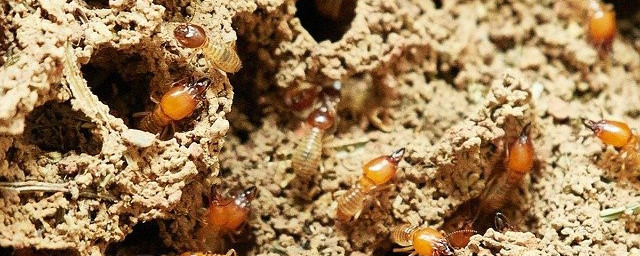
Ugly little buggers aren’t they? They can be in your home before you have any clue that they are munching away at the wooden foundation of your home.

There are signs, however, that you may have termites in your house. The seals or exterior band of boards that your floor joists are connected to and that sits on the plate or top of the foundation would be the first wood that they come to and certainly will not be the last.
Early signs of termites have to be looked for and noticed in order to take your home off of their menu.
I am right now in throes of remodeling an old home that has extensive termite damage and that is why I am writing this article to help you understand these destructive pests and what you can be doing now to avoid the mess I am in right now.
I wanted to know first hand about these creatures after seeing the damage that they dealt to the wooden structure of this home.
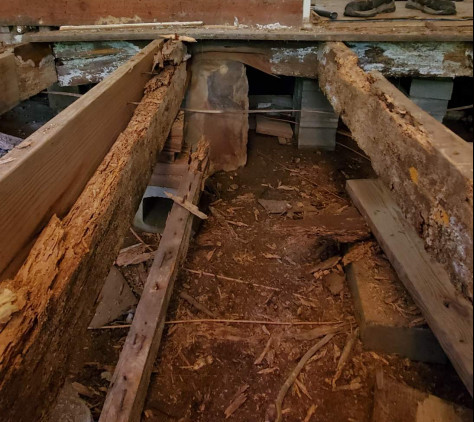
This photo shows that this room had been remodeled years ago. You can see where the carpenter’s sistered pressure treated 2×8’s to the original old sawmill cut wood that was first used to construct this home.
The termites ate almost the entire old original floor joists and did not touch the pressure-treated lumber! The pressure-treated lumber had nails driven through it that gives credence to the fact that at the time of the remodel the old lumber was still in fair shape.
The timeline, as best I could figure, is that the termites had been working on this home prior to that remodel which was done some 40 years ago. This country abode was approximately 100 years old.
It was not just the flooring mind you, no, they ate their way up the walls and into the second story. How could something this small coordinate such devastation, I am wondering, are they still eating my house in another room?
Is there something I can do to protect what’s left if they are? To be able to understand these questions and come up with a plan of attack on this scourge and to also be able to avoid this problem in any future real estate ventures I am going to research this bug.
RESEARCH
There are over 2000 different species of termites known in the world with 45 of these species in the United States. They are grouped into three types or genres: Drywood, Dampwood, and Subterranean.
DRYWOOD TERMITES
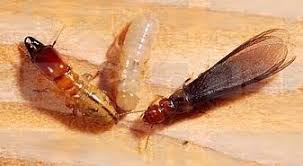
The drywood termite is just its name indicates – dry. They do not have to be near moisture as they extract water from the cellulose and wood that they consume and also from their own feces.
These bugs will infest roof materials and wooden supports and can be found in deadwood around the home. They are normally found in the southern tier states from North Carolina along with the Gulf states and along the coast in California.
After the moisture has been harvested from their own feces it will be expelled from the nest or location to eventually pile up and can be a sign that you have unwanted guests.

These dried feces are called Frass and can resemble granules of sand. They can be found along baseboards, window frames, and door frames.
DAMPWOOD TERMITES

These little swampers are the waterdogs of the termite family and are larger in size than the other two groups. They do not normally infest structures because of the lack of moisture in the dry kiln wood that is used to build wooden structures, such as houses.
They however can be drawn to any wood that stays damp such as from a leaky pipe, water heater, or even a small but continuous long-term roof leak.
Dampwood termites are found around southern Florida and the Pacific coastal states. They can be found in trees and logs around swamps and low-lying damp areas.
SUBTERRANEAN TERMITES
These are the termites that do the most damage and the ones most common throughout the United States, except for Alaska.

These have underground colonies and build mud tunnels into structures, behind walls, and to adjacent food sources. The mud tunnels protect the mites from heat and from drying out as they need to have a constant source of water near in which to thrive.
They are the most destructive and aggressive of all of the world’s termites and originate from China.
Workers are sexually immature males and females and are smaller in size and have no wings. Workers are the first buggers seen when a log or active mud tube is disturbed.
It is the worker’s job to search for food, care for the young, repair the nest, build mud tubes, and feed and groom the others.
Soldiers are also wingless and have the task of protecting the colony. They can be easily recognized with a larger head and dark mandibles or Jaws.
They are dependent on the workers to feed them. Depending on the species of subterranean termite, soldiers can comprise a different percentage of the colony.
Swarmers
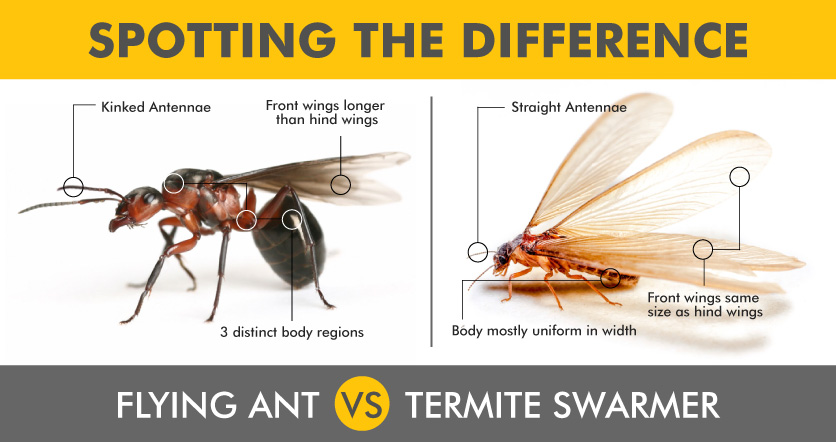
Adult winged termites are called alates or swarmers. They are the only form of the colony that develops eyes and wings with darker bodies and have a thicker outer skin called the cuticle which retards water loss.
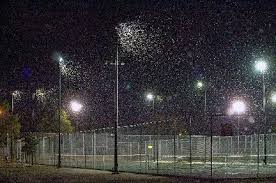
Termites swarm in the spring and anything made of wood is fair game. To make matters worse they are attracted to light! We live in wooden structures with lights! Once a swarmer lands, it sheds its wings, mates, and becomes a primary reproductive—king or queen—of the new colony.
COME ON OVER
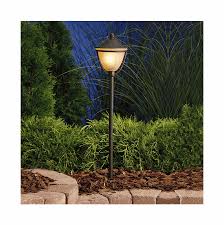
Mind you termites do not live in houses, per se. They are blind and survive in fence posts, woodpiles, downed trees, logs, forest floors rich in leaf fluff, twigs, and branches. If you have a yard light near your house with a flower bed or a shrub line with wood mulch, well you are just inviting the little buggers to your house.
Subterranean termites nest in moist soil. This is important for their survival because they can dry out and die because of the thin like skin called the cuticle. They easily attack any wood in contact with the ground.
If the wood does not contact the soil, they can build mud tunnels or tubes to reach wood many feet above the ground.
These tunnels can extend for 50 to 60 feet to reach the wooden foundation of your home. When A termite finds food it will lay down a pheromone back to the nest to guide the others to a meal.
They will eat anything containing cellulose: paper, fiberboard, and fabrics derived from plant fibers such as cotton. Subterranean termites are by far the most destructive species in the U.S.
Youtube video of a study on just how fast termites can infest a home.
Time to Do Your Termite Inspection

